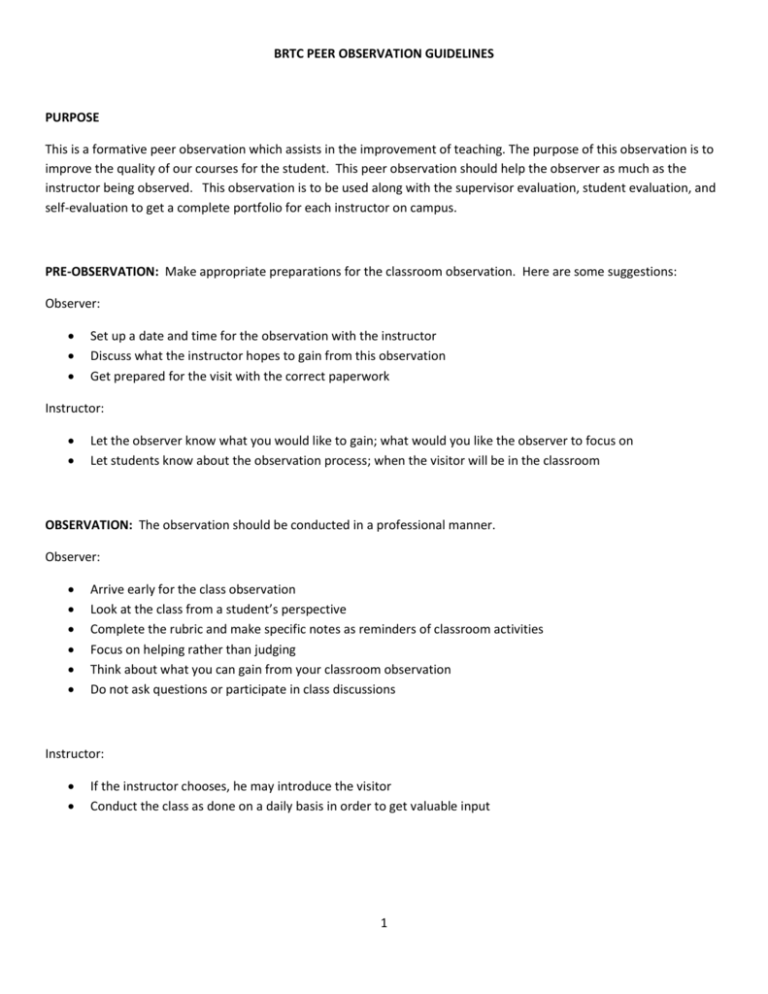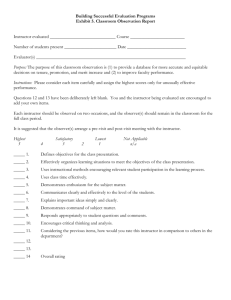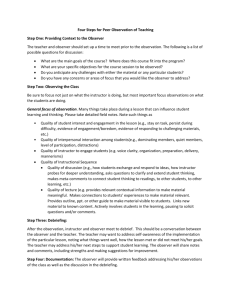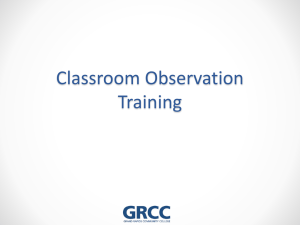BRTC PEER OBSERVATION GUIDELINES PURPOSE This is a
advertisement

BRTC PEER OBSERVATION GUIDELINES PURPOSE This is a formative peer observation which assists in the improvement of teaching. The purpose of this observation is to improve the quality of our courses for the student. This peer observation should help the observer as much as the instructor being observed. This observation is to be used along with the supervisor evaluation, student evaluation, and self-evaluation to get a complete portfolio for each instructor on campus. PRE-OBSERVATION: Make appropriate preparations for the classroom observation. Here are some suggestions: Observer: Set up a date and time for the observation with the instructor Discuss what the instructor hopes to gain from this observation Get prepared for the visit with the correct paperwork Instructor: Let the observer know what you would like to gain; what would you like the observer to focus on Let students know about the observation process; when the visitor will be in the classroom OBSERVATION: The observation should be conducted in a professional manner. Observer: Arrive early for the class observation Look at the class from a student’s perspective Complete the rubric and make specific notes as reminders of classroom activities Focus on helping rather than judging Think about what you can gain from your classroom observation Do not ask questions or participate in class discussions Instructor: If the instructor chooses, he may introduce the visitor Conduct the class as done on a daily basis in order to get valuable input 1 POST-OBSERVATION CONFERENCE: The instructor and observer should meet to reflect on the observation. Both should determine how the observation best helped them. Observer: Reflect on the class from a student’s perspective Read notes as reminders of classroom activities Focus on helping rather than judging Think about what would be helpful for the instructor and yourself Give constructive feedback Instructor: Inform the observer whether or not this was a typical day in class Ask any questions necessary. For example, “Did students seem to be attentive/participating in the class?” This may be difficult to know if you turn your back to write something on the board. Listen to the observations made Discuss what you wish might have gone better SUMMARY This observation should accomplish the following for both persons involved: Offer insight regarding improvement of teaching for both the observer and instructor Gain new ideas and perspectives about teaching from one’s colleagues This is an opportunity to share reflections and observations, to raise questions, to explore your approach to learning and teaching, and to adjust teaching styles to improve the quality of education BRTC students receive. 2 NOTES to the Observer: Some Do's and Don’ts of Peer Observations Do 1. 2. 3. 4. 5. 6. 7. Do treat the instructor with courtesy and respect. Do comment on the performance, not the person. Do focus on how the material is supported (or not), rather than whether you agree or disagree with it. Do aim for balance and completeness in pointing out strengths and opportunities for improvement. Do comment on specific examples of strengths. Do aim to help the instructor see how to improve future work. Do remember that you are to gain knowledge of improving your classroom as well. Don’t 1. Don't confine your comments to mechanical details. 2. Don't make vague, global comments. 3. Don't get into debates over unresolvable questions of individual value and belief (for example, questions relating to religion, gun control, or abortion). 4. Don't argue with the instructor. Ask for explanations only to clarify and suggest ways of strengthening instruction. Keep the peer observation focused and objective. Now is not the time to get revenge on Tommy for getting in front of you at the potluck. The comments contained in the peer observation should be directly related to the overall workplace performance of the individual. Take care to avoid making the review overly negative or positive to show that you're capable of providing useful information. 3






